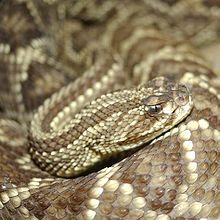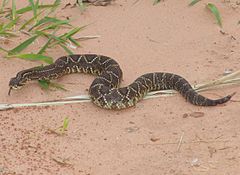- Crotalus durissus
-
Crotalus durissus Venezuelan rattlesnake, C. d. cumanensis Scientific classification Kingdom: Animalia Phylum: Chordata Subphylum: Vertebrata Class: Reptilia Order: Squamata Suborder: Serpentes Family: Viperidae Subfamily: Crotalinae Genus: Crotalus Species: C. durissus Binomial name Crotalus durissus
Linnaeus, 1758Synonyms - Crotalus Dryinas Linnaeus, 1758
- [Crotalus] Durissus Linnaeus, 1758
- Caudisona orientalis Laurenti, 1768
- Caudisona Gronovii Laurenti, 1768
- Crotalus orientalis - Gmelin, 1788
- Crotalus strepitans var. dryinas - Daudin, 1803
- [Urocrotalon] durissus - Fitzinger, 1843
- Uropsophus durissus - Gray, 1849
- Crotalus durissus - Boulenger, 1896
- Crotalus pulvis Ditmars, 1905
- [Crotalus] terrificus durissus - Amaral, 1929
- Crotalus terrificus durissus - Amaral, 1929
- [Crotalus] Gronovii - Klauber, 1936
- Crotalus durissus dryinus - Hoge, 1966
- Crotalus (Crotalus) durissus dryinus - Peters & Orejas-Miranda, 1970[1][2]
Crotalus durissus is a venomous pitviper species found in South America. The most widely distributed member of its genus,[1] this species poses a serious medical problem in many parts of its range.[4] Currently, 9 subspecies are recognized, including the nominate subspecies described here.[5]
Contents
Description
Grows to a maximum length of about 180 cm (about 6 feet).[1]
Common names
South American rattlesnake,[1] tropical rattlesnake,[3] neotropical rattlesnake,[6] Guiana rattlesnake (previously used for C. d. dryinus).[7]
Spanish: víbora de cascabel, cascabel, cascabela, cascavel.[1]
Geographic range
Found in all South American countries except Ecuador and Chile. However, its range is discontinuous,[1] with many isolated populations in northern South America, including Colombia, Venezuela, Guyana, Suriname, French Guiana and northern Brazil. It occurs in Colombia and eastern Brazil to southeastern Peru, Bolivia, Paraguay, Uruguay, and northern Argentina (Catamarca, Córdoba, Corrientes, Chaco, Entre Rios, Formosa, La Pampa, La Rioja, Mendoza, Misiones, San Juan, San Luis, Santa Fe, Santiago del Estero and Tucumán).[2] Also occurs on some islands in the Caribbean, including Morro de la Iguana, Tamarindo and Aruba.[1] The type locality given is "America."[2]
Habitat
Prefers savanna, caatinga and cerrado. It has been reported to occur in littoral xerophilous scrub, psammophilous and halophilous littoral grassland thorny xerophilous scrub, tropophilous deciduous and semidesciduous scrub, as well as tropophilous semidesciduous seasonal forest in the northwest of Venezuela. In the Chaco region of Paraguay, it is said to prefer the drier, sandier areas (Böckeler, 1988).[1]
Venom
Bite symptoms are very different from those of Nearctic species[8] due to the presence of neurotoxins (crotoxin and crotamine) that cause progressive paralysis.[4] Bites from C. d. terrificus in particular can result in impaired vision or complete blindness, auditory disorders, ptosis, paralysis of the peripheral muscles, especially of the neck, which becomes so limp as to appear broken, and eventually life-threatening respiratory paralysis. The ocular disturbances, which according to Alvaro (1939) occur in some 60% of terrificus cases, are sometimes followed by permanent blindness.[8] Phospholipase A2 neurotoxins also cause damage to skeletal muscles and possibly the heart, causing general aches, pain and tenderness throughout the body. Myoglobin released into the blood results in dark urine. Other serious complications may result from systemic disorders (incoagulable blood and general spontaneous bleeding), hypotension and shock.[4] Hemorrhagins may be present in the venom, but any corresponding effects are completely overshadowed by the startling and serious neurotoxic symptoms.[8]
Taxonomy
The Guiana rattlesnake, previously recognized as C. d. dryinus,[2] is now considered a synonym for C. d. durissus. In fact, after the previous nominate subspecies for the durissus complex became the current nominate for C. simus, which now represents its Mexican and Central American members, C. d. dryinus became the new nominate for the South American rattlesnakes as represented by C. durissus.[1] The subspecies previously known as C. d. collilineatus and C. d. cascavella were moved to the synonymy of C. d. terrificus following the publication of a paper by Wüster et al. in 2005.
Subspecies
Subspecies[ref 1] Taxon author[ref 1] Common name Geographic range C. d. cumanensis Humboldt, 1833 Venezuelan rattlesnake[ref 2] Dry lowlands of Venezuela and Colombia C. d. durissus Linnaeus, 1758 South American rattlesnake[ref 3] Coastal savannas of Guyana, French Guyana and Suriname C. d. marajoensis Hoge, 1966 Marajon rattlesnake[ref 4] Known only from Marajo Island, Para State, Brazil C. d. maricelae García Pérez, 1995 Bolson arido de Lagunillas, Estado Merida, Venezuela C. d. ruruima Hoge, 1966 Known from the slopes of Mount Roraima and Mount Cariman-Perú in Venezuela (Bolívar). A few specimens have been recorded in Brazil (Roraima).[ref 3] C. d. terrificus (Laurenti, 1768) Cascavel[ref 2] Brazil south of the Amazonian forests, extreme southeastern Peru, Bolivia, Paraguay, Uruguay, northern Argentina C. d. trigonicus Harris & Simmons, 1978 Inland savannas of Guyana C. d. unicolor Lidth de Jeude, 1887 Aruba Island rattlesnake[ref 5] Aruba Island, off the coast of Venezuela.[ref 5] C. d. vegrandis Klauber, 1941 Uracoan rattlesnake[ref 5] Venezuela in Monagas.[ref 5] - ^ a b "Crotalinae". Integrated Taxonomic Information System. http://www.itis.gov/servlet/SingleRpt/SingleRpt?search_topic=TSN&search_value=634394. Retrieved 26 October 2006.
- ^ a b Mehrtens JM. 1987. Living Snakes of the World in Color. New York: Sterling Publishers. 480 pp. ISBN 0-8069-6460-X.
- ^ a b Campbell JA, Lamar WW. 2004. The Venomous Reptiles of the Western Hemisphere. Comstock Publishing Associates, Ithaca and London. 870 pp. 1500 plates. ISBN 0-8014-4141-2.
- ^ Brown JH. 1973. Toxicology and Pharmacology of Venoms from Poisonous Snakes. Springfield, Illinois: Charles C. Thomas. 184 pp. LCCCN 73-229. ISBN 0-398-02808-7.
- ^ a b c d Klauber LM. 1997. Rattlesnakes: Their Habitats, Life Histories, and Influence on Mankind. Second Edition. 2 volumes. Reprint, University of California Press, Berkeley. ISBN 0-520-21056-5.
See also
- List of crotaline species and subspecies
- Crotalus by common name
- Crotalus by taxonomic synonyms
- Crotalinae by common name
- Crotalinae by taxonomic synonyms
- Snakebite
References
- ^ a b c d e f g h i j Campbell JA, Lamar WW. 2004. The Venomous Reptiles of the Western Hemisphere. Comstock Publishing Associates, Ithaca and London. 870 pp. 1500 plates. ISBN 0-8014-4141-2.
- ^ a b c d McDiarmid RW, Campbell JA, Touré T. 1999. Snake Species of the World: A Taxonomic and Geographic Reference, vol. 1. Herpetologists' League. 511 pp. ISBN 1-893777-00-6 (series). ISBN 1-893777-01-4 (volume).
- ^ a b Mehrtens JM. 1987. Living Snakes of the World in Color. New York: Sterling Publishers. 480 pp. ISBN 0-8069-6460-X.
- ^ a b c Warrell DA. 2004. Snakebites in Central and South America: Epidemiology, Clinical Features, and Clinical Management. In Campbell JA, Lamar WW. 2004. The Venomous Reptiles of the Western Hemisphere. Comstock Publishing Associates, Ithaca and London. 870 pp. 1500 plates. ISBN 0-8014-4141-2.
- ^ "Crotalus durissus". Integrated Taxonomic Information System. http://www.itis.gov/servlet/SingleRpt/SingleRpt?search_topic=TSN&search_value=563936. Retrieved 28 November 2007.
- ^ U.S. Navy. 1991. Poisonous Snakes of the World. US Govt. New York: Dover Publications Inc. 203 pp. ISBN 0-486-26629-X.
- ^ Brown JH. 1973. Toxicology and Pharmacology of Venoms from Poisonous Snakes. Springfield, Illinois: Charles C. Thomas. 184 pp. LCCCN 73-229. ISBN 0-398-02808-7.
- ^ a b c Klauber LM. 1997. Rattlesnakes: Their Habitats, Life Histories, and Influence on Mankind. Second Edition. 2 volumes. Reprint, University of California Press, Berkeley. ISBN 0-520-21056-5.
Further reading
- Alvaro ME. 1939. Snake Venom in Ophthalmology. Am. Jour. Opth., Vol. 22, No. 10, pp. 1130-1145.
- Wüster W, Ferguson JE, Quijada-Mascareñas JA, Pook CE, Salomão MG, Thorpe RS. 2005. Tracing an invasion: landbridges, refugia and the phylogeography of the Neotropical rattlesnake (Serpentes: Viperidae: Crotalus durissus). Molecular Ecology 14: 1095-1108. PDF at Wolfgang Wüster. Accessed 28 August 2007.
- Wüster W, Ferguson JE, Quijada-Mascareñas JA, Pook CE, Salomão MG, Thorpe RS. 2005. No rattlesnakes in the rainforests: reply to Gosling and Bush. Molecular Ecology, 14: 3619-3621. PDF at Wolfgang Wüster. Accessed 28 August 2007.
- Quijada-Mascareñas A, JE Ferguson, CE Pook, MG Salomão, RS Thorpe, & W Wüster. 2007. Phylogeographic patterns of Trans-Amazonian vicariants and Amazonian biogeography: The Neotropical rattlesnake (Crotalus durissus complex) as an example. Journal of Biogeography 34: 1296–1312.
External links
- Crotalus durissus at the Reptarium.cz Reptile Database. Accessed 19 August 2007.
Categories:
Wikimedia Foundation. 2010.


